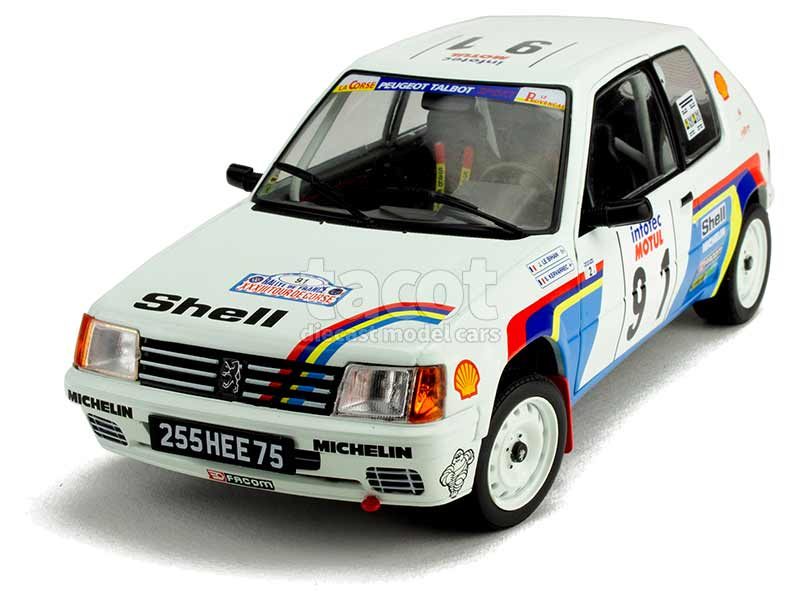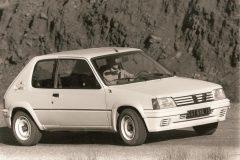It has been another 35 years ago that Peugeot introduced the 205. That brave toy became a huge success.
Sales went well!
Peugeot was pleasantly surprised to find that more than 5,3 million were running over the counter. For the most part, they were of course hand-held 205s. If you wanted more peppers under the hood, 205, you could opt for the 1.6 GTI and later the 1.9 GTI. But as the icing on the cake, there was also a very nasty 205 that caught sporty driving in its most naked essence: the 205 Rallye.
The Peugeot 205 Rallye: a brave poison frog
In 1988 and 1989, Peugeot built the 205 Rallye with the 1,3-liter block. Then came an 1,9 liter version, which was built from 1990 to 1992, but only sold in Germany's Total Unlimited. The idea behind the Rallye was that for people without money for a GTI a real fun play car had to be created. The 205 Rallye cost 26.580 guilders. Including the tough wheel arch wideners and the exhaust system of the 1600 GTI.
The entire cooling system was also adapted to the fiercest deployment. The engine character asked for it to be driven firmly. With the whip over it, such a Rallye ran a line or something over the 190 km / h.
The 205 Rallye was built by Peugeot-Talbot Sport
The block that was in the 1,3 liter Rallye was a somewhat tickled, 1300 version of the TU1 and was called TU24 because of its festive double Webers. The block was just over the 100 hp and with the weight of only 794 kilo, that resulted in a very spicy car. To race from 0-100, Peugeootje needed 9,6 seconds. The extra muscular 1,9-liter GTI was 1,1 second faster, but that also cost 33.000 rock-hard guilders. Everything has its price.
Weight watching
To please the scales, Peugeot completely stripped the car of everything that was not necessarily necessary. Opening windows was simply with the pendulum and damping insulation material was largely forgotten. The Rallye was only available in white or yellow, with the Peugeot Talbot Sport logo everywhere.
Under the skin, as already mentioned, the car had a lot of technology from the 1,6-liter GTI. For example, the car had the same suspension at the front, including the ventilated disc brakes. The rear axle also came from under the GTI.
The occupants in the front were seated on two excellent bucket seats with flashing red safety belts. The passengers in the back seat ... Oh, never mind. At least something had been taken into account: the rear seat had three belts. Thanks to the exuberant exhaust system, the occupants were hardly bothered by possible annoying mechanical or wind noises.
The puristic, sporty 205 Rallye proved to work; 30.111 were sold, of which Peugeot originally hoped to make 5.000 copies.
Yet this rapid 205 remained in the shadow of the GTI, of which more than 330.000 were sold. That makes the 205 Rallye a lot more exclusive today.
We found an 1900 with 250.000 kilometers on the clock (and a revised block and such) for an asking price of just under 8.000 euros and an 1300 with almost 185.000 mileage experience with an asking price of 12.500 euros. The most expensive 250 Rallye that we found cost 27.500 euros.
Preferably leave copies with a competition history. If you want to own something extra sporty, then there are plenty of suppliers of virgin scale models. And with some cutting and pasting, they just look real.







The 205 1.3 Rallye is a unique and special car and it is almost unreal to realize that Peugeot was able to market this as a production car for a competitive price. The Rallye was intended as a homologation model that met FIA requirements in order to offer an affordable but specific rally car in the class up to 1300cc. Peugeot itself has also participated in championships with the 205 1.3 Rallyes, although the successes achieved are of course always in the shadow of those of the 205 T16. The Rallye's TU24 engine is unique and based on the well-known 1.1 block, but equipped with a unique cylinder head with very large inlet and exhaust valves, different camshafts, crankshaft, pistons, piston rods, cylinders and of course the 2 large double Weber carburetors. This block was developed by Danielson, a high-tech engineering company that, among others, also does projects for Airbus. The body of the Rallye is welded at many points and is therefore much stiffer and stronger than that of the other 205 models. The engine was coupled to a modified gearbox with specific ratios, making it possible to always keep the engine in its most optimal speed range. In the 80s, Peugeot was very reluctant to give up specifications. These are almost always minimum "under" values that all engines at least meet. This means that most engines are often more powerful than the specified values and this can sometimes be surprisingly much higher. In practice, this means that a Rallye can usually be (considerably) faster than a 205 GTi, because the available power is more accessible and more responsive. With a different exhaust and a more open filter, a little Rallye can easily achieve approximately 110 HP or a bit more. The 1.3 Rallye was built and delivered from 1988 to 1992, but was only available in the Netherlands for about a year from 1988 to 1989. As a result, original 205 Rallyes delivered in the Netherlands are very rare because at most only a few 100 of them were sold. . The model was especially popular in Spain. Many examples have been lost in motorsport, where you can still encounter the 205 Rallye a lot, especially in Southern Europe. It is therefore very understandable and also quite logical that the 205 rallye has been enjoying growing interest among car enthusiasts and collectors for some time. This translates into a steadily increasing value, comparable to that of the classic Alfa Giulia GTa and the BMW E30 M3.
Yes, it turns out Cornelius, you apparently stick to the facts too.
Just like Rjab, I also have the idea that some is being smuggled with numbers.
in any case, the GTi was there in an 1.6 with 105 hp, later a somewhat boosted 1.6 with 115 Hp (I myself had at the time) and the 130 hp strong 1.9 version.
The 1.9 did 0 to 100 in 7,9 sec according to the folder, unfortunately I cannot find it now. and the 0 to 100 in 9,6 sec was for the 1.6 with 105 hp and there the 1.3 version really stayed above .des already a nice car.
Am a bit confused: always thought that t were an 1.6 and 1,9 gti. Is there now a number of times 1,3. 😬
Yes, yes, gentlemen responders, reading is an art.